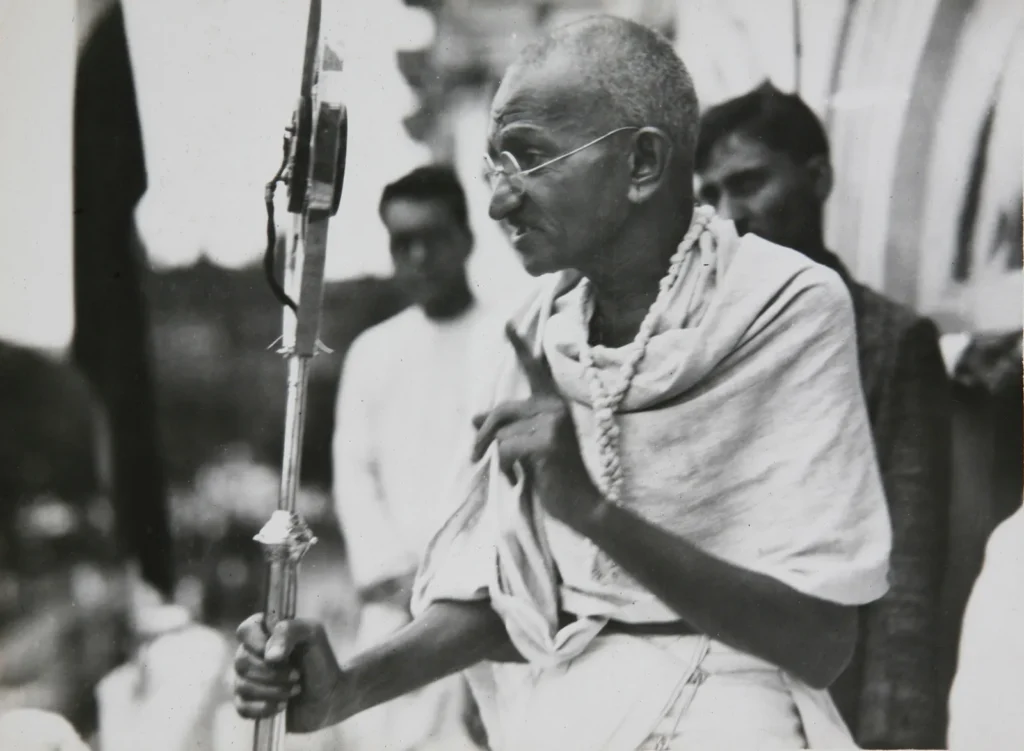Mahatma Gandhi, often called the “Father of the Nation” in India, played a pivotal role in the country’s struggle for independence from British rule. His philosophy of non-violence (Ahimsa) and civil disobedience (Satyagraha) became powerful tools in the fight against colonial oppression. Gandhi’s leadership not only united millions of Indians across diverse backgrounds but also inspired global movements for civil rights and freedom. His emphasis on truth, simplicity, and self-reliance continues to influence leaders and activists worldwide, making him a timeless symbol of peaceful resistance and moral integrity.
Early Life and Education
Birth and Family Background
Mahatma Gandhi was born on October 2, 1869, in Porbandar, a coastal town in present-day Gujarat, India. His full name was Mohandas Karamchand Gandhi. He came from a well-off family; his father, Karamchand Gandhi, was the dewan (chief minister) of Porbandar, and his mother, Putlibai, was a deeply religious woman who had a significant influence on his early life.
Education in India and London
Gandhi’s early education took place in Rajkot, where he was an average student but showed a keen interest in moral and religious subjects. At the age of 19, he traveled to London to study law at University College London. This period was crucial as he was exposed to Western ideas and philosophies, which broadened his perspective.
Early Influences and Experiences that Shaped His Worldview
Several key experiences and influences shaped Gandhi’s worldview. His mother’s devoutness instilled in him a strong sense of morality and discipline. In London, he was influenced by the teachings of Jesus Christ, the Bhagavad Gita, and the works of Leo Tolstoy and John Ruskin. These influences, combined with his personal experiences of racial discrimination in South Africa, where he worked as a lawyer, led him to develop his principles of non-violence and civil disobedience, which would later become the cornerstone of his activism.
Gandhi in South Africa
Arrival in South Africa and Initial Experiences
Mahatma Gandhi arrived in South Africa in 1893 to serve as legal counsel for an Indian merchant, Dada Abdulla. His journey to Pretoria marked a turning point when he was thrown off a train for refusing to move from a first-class compartment despite holding a valid ticket. This incident exposed him to the harsh realities of racial discrimination and ignited his resolve to fight injustice.
Key Events that Led to His Activism
Several key events in South Africa galvanized Gandhi’s activism. The most notable was the introduction of the Black Act in 1906, which required all Indians to register and carry identification passes. Gandhi organized mass protests and encouraged Indians to defy the law, leading to widespread arrests. His leadership in these protests earned him recognition and respect within the Indian community.
Development of the Concept of Satyagraha
During his time in South Africa, Gandhi developed the concept of Satyagraha, which means “truth force” or “soul force.” This philosophy of non-violent resistance was based on the principles of truth and non-violence. Gandhi believed that non-violent protest was the most powerful way to confront and overcome oppression. The success of Satyagraha in South Africa laid the foundation for its application in India’s struggle for independence and inspired future civil rights movements worldwide.
Return to India and Early Activism
Return to India in 1915
Mahatma Gandhi returned to India in 1915 after spending over two decades in South Africa. His arrival was met with great anticipation, as his reputation as a leader of non-violent resistance had preceded him. Gandhi was determined to apply the principles of Satyagraha to India’s struggle for independence.
Initial Movements and Campaigns

Upon his return, Gandhi embarked on a journey across India to understand the conditions and grievances of the common people. His first major campaign was the Champaran Satyagraha in 1917, where he fought for the rights of indigo farmers who were being exploited by British planters. This successful movement was followed by the Kheda Satyagraha in 1918, where he supported farmers affected by crop failure and plague, advocating for tax relief.
Role in the Indian National Congress
Gandhi’s early successes earned him a prominent role in the Indian National Congress (INC). He became a key figure in the party, advocating for non-violent resistance and mass mobilization. Under his leadership, the INC transformed from an elite organization into a mass movement that included people from all walks of life. Gandhi’s strategies and campaigns, such as the Non-Cooperation Movement, laid the groundwork for future struggles against British rule and solidified his position as a central leader in India’s fight for independence.
Major Movements and Campaigns
Non-Cooperation Movement (1920-1922)
The Non-Cooperation Movement was Gandhi’s first large-scale attempt at challenging British authority. Launched in response to the Jallianwala Bagh massacre and other repressive measures, it called for Indians to withdraw from British institutions, including schools, courts, and government services. The movement aimed to paralyze the British administration and promote self-reliance through the revival of indigenous industries.
Civil Disobedience Movement and the Salt March (1930-1934)
The Civil Disobedience Movement marked a significant escalation in Gandhi’s campaign against British rule. It began with the iconic Salt March in 1930, where Gandhi and his followers marched 240 miles to the Arabian Sea to produce salt, defying British laws that imposed a monopoly on salt production. This act of defiance galvanized the nation, leading to widespread nonviolent protests and boycotts of British goods.
Quit India Movement (1942)
The Quit India Movement was Gandhi’s final major campaign for independence. Launched in August 1942, it called for an immediate end to British rule in India. The movement was marked by mass protests, strikes, and acts of civil disobedience. Despite severe repression by the British authorities, the movement intensified the demand for independence and set the stage for India’s eventual freedom in 1947.
Philosophy and Principles
Explanation of Satyagraha and Ahimsa (Non-Violence)
- Satyagraha: This term combines the Sanskrit words “Satya” (truth) and “Agraha” (insistence or holding firmly to). Gandhi’s Satyagraha was a method of nonviolent resistance and civil disobedience. It was not just a political tool but a moral philosophy that emphasized the power of truth and the need to stand firm against injustice without resorting to violence. Satyagraha aimed to convert the oppressor through self-suffering and moral persuasion rather than force.
- Ahimsa: Often translated as non-violence, Ahimsa goes beyond the mere absence of violence. It is an active force of love and compassion that seeks to do no harm in thought, word, or deed. Gandhi believed that Ahimsa was a way of life that required immense courage and strength, as it involved resisting evil with good and transforming adversaries through understanding and patience.
Gandhi’s Views on Self-Reliance and Swadeshi
- Self-Reliance: Gandhi championed the idea of self-reliance, believing that true independence could only be achieved if individuals and communities were economically self-sufficient. He encouraged the revival of traditional crafts and industries, particularly spinning and weaving, to reduce dependence on British goods and promote local economies.
- Swadeshi: The Swadeshi movement was an integral part of Gandhi’s economic philosophy. Swadeshi, meaning “of one’s own country,” advocated for the use of domestically produced goods and the boycott of foreign products. This movement aimed to empower local artisans and farmers, foster national pride, and weaken the economic foundations of British rule in India.
Personal Life and Character

Family Life and Relationship with Kasturba Gandhi
Gandhi’s relationship with his wife, Kasturba Gandhi, was a cornerstone of his personal life. They were married in 1883 when Gandhi was just 13 years old. Kasturba, affectionately known as Ba, was a steadfast companion and supporter of Gandhi’s endeavors. Despite the challenges of their early marriage, including Gandhi’s initial attempts to impose his ideals on her, their relationship evolved into a partnership based on mutual respect and shared commitment to social causes. Kasturba played a crucial role in Gandhi’s movements, often participating in protests and enduring imprisonment alongside him.
Personal Habits, Lifestyle, and Simplicity
Gandhi’s lifestyle was marked by simplicity and self-discipline. He believed in living a life that was in harmony with his principles of non-violence and truth.
- Diet and Health: Gandhi was a strict vegetarian and experimented with various diets to find the most ethical and healthful way of living. He often fasted as a form of protest and self-purification, believing that self-control over one’s desires was essential for personal and social transformation.
- Daily Routine: His daily routine was meticulously planned and included time for prayer, spinning yarn (as part of the Swadeshi movement), and community service. Gandhi emphasized the importance of manual labor and self-sufficiency, often engaging in tasks like cleaning and cooking.
- Simplicity: Gandhi’s commitment to simplicity was evident in his attire. He adopted the loincloth and shawl, traditional Indian garments, as a symbol of solidarity with the poor and a rejection of Western materialism. His simple lifestyle was a powerful statement against the excesses of colonial rule and a call for a return to indigenous values.
Legacy and Impact
Gandhi’s Influence on Global Leaders and Movements
- Martin Luther King Jr.: The American civil rights leader drew heavily on Gandhi’s methods during the Civil Rights Movement. King’s commitment to non-violence and peaceful protest was directly inspired by Gandhi’s successful campaigns against British colonial rule.
- Nelson Mandela: In South Africa, Mandela adopted Gandhi’s principles in the struggle against apartheid. Mandela’s emphasis on reconciliation and non-violent resistance echoed Gandhi’s approach, even as he faced severe repression.
- The Dalai Lama: The spiritual leader of Tibet has often cited Gandhi as a major influence on his own philosophy of non-violence and compassion. The Dalai Lama’s peaceful resistance to Chinese rule in Tibet mirrors Gandhi’s strategies.
His Enduring Legacy in India and Around the World
- In India: Gandhi is revered as the “Father of the Nation.” His efforts were instrumental in achieving India’s independence in 1947. His teachings continue to influence Indian society, politics, and culture. The principles of self-reliance and Swadeshi he advocated are still relevant in contemporary economic policies and social movements.
- Globally: Gandhi’s impact is evident in various international movements for civil rights, social justice, and environmental sustainability. His ideas have been incorporated into the United Nations’ principles and continue to inspire global peace initiatives. His birthday, October 2nd, is celebrated as the International Day of Non-Violence, underscoring his global influence.
Key Points
About Mahatma Gandhi
- Full Name: Mohandas Karamchand Gandhi
- Birthdate: October 2, 1869
- Birthplace: Porbandar, Gujarat, India
- Parents: Karamchand Gandhi (father), Putlibai Gandhi (mother)
Family
- Wife: Kasturba Gandhi (married in 1883)
- Children: Four sons – Harilal, Manilal, Ramdas, Devdas
Education and Early Career
- Education: Studied law at University College, London
- Career: Worked as a lawyer in South Africa, where he first faced racial discrimination and developed his philosophy of non-violence (Satyagraha).
Role in Indian Independence
- Non-violent Resistance: Advocated for peaceful protests against British rule.
- Key Movements:
- Champaran Movement (1917): Fought for farmers’ rights in Bihar.
- Non-Cooperation Movement (1920–22): Urged Indians to boycott British goods.
- Salt March (1930): Protested against the British salt tax.
- Quit India Movement (1942): Demanded the British leave India.
Philosophy and Beliefs
- Ahimsa (Non-violence): Gandhi believed in resolving conflicts without violence, a principle he used in both personal life and political activism.
- Satyagraha (Truth): Stood for truth as a tool for civil resistance.
- Self-reliance: Advocated the Swadeshi movement, promoting the use of Indian-made goods to empower local industries.
- Sarvodaya (Welfare of All): Worked for the upliftment of the poor and the marginalized.
Gandhi’s Vegetarianism
- Cultural Roots: Born in a Vaishnav family, where vegetarianism was practiced.
- Ethical Reasons: Gandhi believed that being vegetarian aligned with his commitment to non-violence and compassion for all living beings.
Assassination
- Date of Death: January 30, 1948
- Place of Death: Birla House, New Delhi (now Gandhi Smriti)
- Assassinated by: Nathuram Godse
Gandhi on Indian Currency
- First Appearance: Gandhi’s image was first included on Indian currency notes in 1969 for his 100th birth anniversary.
- 1996 Series: The current series of Indian currency featuring his smiling portrait was introduced in 1996.
Global Influence and Statues
- Statues Around the World: Gandhi’s statues are found in various countries, symbolizing his global impact. Some notable locations include:
- London, UK: Parliament Square
- Washington, D.C., USA: Outside the Indian Embassy
- Johannesburg, South Africa: Gandhi Square
- Melbourne, Australia: University of Melbourne
- Moscow, Russia: Lomonosov Moscow State University
Gandhi’s Relevance Today
- Non-violence and Truth: His principles are crucial for promoting peace in a modern, conflict-driven world.
- Self-reliance: Encourages India’s continued efforts to strengthen local industries and reduce dependence on imports.
- Communal Harmony: His vision for unity is vital for fostering peace among diverse religious and cultural communities in India.
- Cleanliness and Sanitation: Gandhi’s early campaigns for sanitation are echoed today in the Swachh Bharat Mission.
- Social Justice: His focus on the welfare of the poor highlights the ongoing need for equity and inclusion in India’s development.
Gandhi’s Legacy
- The title “Mahatma” was given to Mohandas Karamchand Gandhi by Rabindranath Tagore, the renowned poet and Nobel laureate. The word “Mahatma” means “Great Soul” in Sanskrit.
- Global Inspiration: Gandhi’s methods inspired movements worldwide, including the Civil Rights Movement led by Martin Luther King Jr. and anti-apartheid struggles in South Africa.
- International Day of Non-Violence: His birthday, October 2, is observed globally as the International Day of Non-Violence.
Conclusion
Mahatma Gandhi’s life and work have left an indelible mark on the world. His unwavering commitment to non-violence, truth, and justice transformed the struggle for Indian independence and inspired countless movements for civil rights and social change globally. Gandhi’s principles of Satyagraha and Ahimsa demonstrated the power of peaceful resistance and moral integrity in the face of oppression.
His advocacy for self-reliance and the Swadeshi movement emphasized the importance of economic independence and cultural pride. Gandhi’s personal life, marked by simplicity and self-discipline, reflected his deep ethical convictions and his belief in living one’s values.
Gandhi’s legacy continues to resonate today, reminding us of the enduring power of non-violence and the profound impact one individual can have on the world. His teachings remain a beacon of hope and a guide for those striving for justice, equality, and peace.
FAQ’s
Q. Who was Mahatma Gandhi?
A: Mahatma Gandhi, born Mohandas Karamchand Gandhi, was a leader in India’s nonviolent struggle for independence from British rule. He is known for his philosophy of Satyagraha, or peaceful resistance, and is often called the “Father of the Nation” in India.
Q. What is Mahatma Gandhi famous for?
A: Gandhi is most famous for leading India to independence through nonviolent protests, including the Salt March, and for his principles of truth (Satya) and nonviolence (Ahimsa). His methods influenced civil rights movements around the world.
Q. Why is Mahatma Gandhi called the “Father of the Nation”?
A: Gandhi is called the “Father of the Nation” in India because of his pivotal role in leading India’s freedom struggle and his efforts to unify the country through his principles of nonviolence and social justice.






